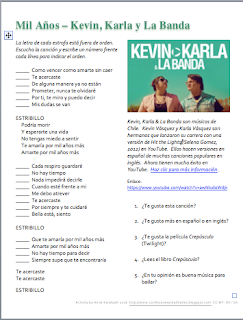So this year I decided to share Thanksgiving vocabulary and talk a bit about traditions and food in class. The discussion in second period was especially fun because we have an exchange student from Barcelona with us, and she has never experienced the holiday before. Students were gushing about the deliciousness of pumpkin pie (mostly in Spanish!) and about how she was going to love stuffing. When we were done discussing, I then asked my students to organize their thoughts into a graphic organizer. We completed the activity with a brief writing about what we will eat and do on Thanksgiving, who we will see, and what we are grateful for.
I have a copy of the organizer here for you, of course.
And in case you are new around here at Confesiones y Realidades, I have posted a couple other Thanksgiving activities in years past. Here are a few in case you are looking for something to do with your classes.
If you are feeling creative, you might want to do Verb Turkeys! Good times, good times.
If you want to review vocabulary with your students, I have a Power Point. It is editable, so you can add your own vocabulary and take out slides as you wish.
And the above-mentioned activity I have my students do alternating years is for sale at Teachers Pay Teachers. It contains a reading with vocabulary, pre-reading, and comprehension activities. It also contains a culminating activity in which students research Thanksgiving in Puerto Rico and plan a fiesta. (Rumors are that there is a secret bonus file in the package too . . . shhh!) It's a brilliant value for $2.50, if I do say so myself.
And in case you have little ones in your classes - ages 6-10 or thereabouts, I even have a fun packet for them available too. It has puzzles, vocabulary, drawing, and coloring - all in Spanish, of course.
All in all, I hope you have a happy Thanksgiving wherever you are. And I hope your students have fun exploring the holiday in Spanish.
Hasta pronto,
--AnneK
































